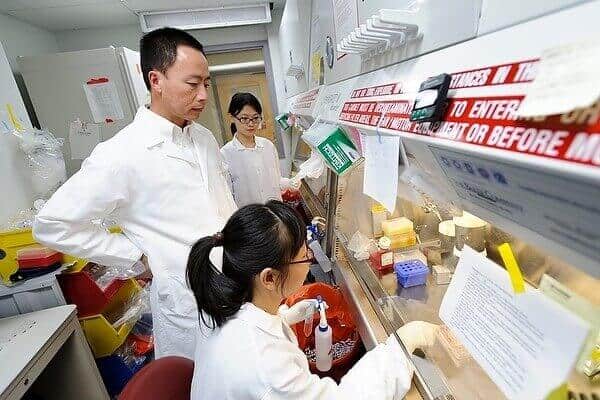This story starts in 1955, upon the death of Albert Einstein, when the pathologist charged with performing the famous scientist’s autopsy stole his brain.
Fast forward to the 1980s when a University of California, Berkeley scientist was studying parts of the stolen goods involved in complex thinking and discovered that the father of relativity had more of certain types of cells, called astrocytes, than other human brains studied.
Today, another 30 years later, scientists still don’t have a solid grasp on everything these cells do in the human nervous system, largely because they’re difficult to study. But Su-Chun Zhang, a professor of neuroscience and neurology at the University of Wisconsin-Madison Waisman Center, and his research team have published a unique model for learning more about the role of human astrocytes in the Journal of Clinical Investigation today.
The findings may lay a foundation for the treatment of a number of neurodegenerative diseases, including ALS (amyotrophic lateral sclerosis) and debilitating spinal cord injuries.
“We expect astrocytes may help neuronal survival and improve disease conditions in ALS and spinal cord injury,” says Zhang. “Both studies are now ongoing because of these findings.”
Astrocytes — so named because of their star shape — are thought to perform a number of important roles in the human brain and spinal cord, and in human health and disease. Animal studies show they are necessary for the development and maintenance of healthy neurons, proper nervous system signaling, and in the formation and maintenance of the crucial blood-brain barrier.
Defects in astrocyte function are associated with ALS and diseases like Rett syndrome, Alexander disease and Huntington’s disease.
“We know very little about human astrocytes, yet people think they are crucial in human health and disease,” says Zhang, also in the Departments of Neuroscience and Neurology at UW-Madison. “But studying astrocytes is very difficult.”
This is especially true of studying human astrocytes in adults. Previous studies have used newborn mice, which provide a different biological environment for astrocytes, yet at least some of these neurodegenerative diseases, and many spinal cord injuries, occur in human adults.
Lead study author Hong Chen, a physician and scientist, transplanted immature human nervous system cells — generated from adult stem cells — into the spinal cords of mice. These cells matured into astrocytes.
The researchers checked in from time to time, and within nine months, found the astrocytes had traveled long distances along the mouse spinal cord, hugging the mouse neurons, connecting to blood vessels and joining with one another, just as mouse astrocytes do. They replaced the mouse astrocytes in the process, but did not affect the ability of the mice to function normally.
“It was shocking because how could that happen?” Zhang says. “Even I could not explain it. I joked that the human astrocytes are smarter.”
Zhang suspects what may actually be happening is the human astrocytes are out-dividing their smaller, mouse counterparts, developing in larger numbers and essentially “bullying” the mouse cells out.
The researchers repeated the experiments with astrocytes matured from human patients with ALS. The astrocytes replaced the mouse astrocytes, behaving just like those from nonALS individuals, except they disrupted motor function in the mice, just like in ALS.
“They have problems with movement in their legs and were just beginning to show signs of neuron degeneration,” says Zhang. “It shows it’s not just a physical replacement, it’s really a functional integration with consequence.”
This is important to Zhang, who holds a medical degree and is driven to take the successes in the lab to human patients in the clinic.
“Because of my medicine background, I think about how stem cells can be utilized for medical purposes,” he says. “I really want to push hard to potentially treat spinal cord injury, and especially ALS. It’s so devastating, and after so long, there is still no treatment.” The study was supported by the National Institutes of Health, two families familiar with spinal cord injury — the Bleser Family Foundation and the Busta Foundation — and the Eunice Kennedy Shriver National Institute of Child Health and Human Development.


